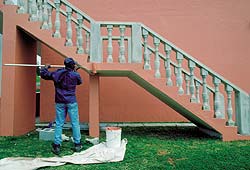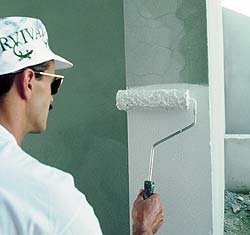
EWC - Elastomeric Paint,
Exterior Paint
EWC (Elastomeric Wall Covering) or Elastomeric Paint is flexible and stretchable and can rescue a job that requires painting masonry or concrete.
by Susan Brimo-Cox
masonry expands and contracts with changes in temperature. As a result, surface cracks are inevitable. However, masonry’s structural integrity can be undermined if moisture and other damaging elements penetrate those cracks. What to do? Elastomeric wall coatings (EWCs) may be the solution.
Originally developed in Europe in the 1940s, EWCs weren’t introduced to North America until the mid-1980s. Since then, they have really caught on for both commercial and residential applications.
 The dilemma before EWCs was that other coatings didn’t have the flexibility to expand and contract effectively with a masonry substrate. The coatings would crack themselves. The development of special binders that provide the necessary flexibility and elasticity is one of the keys to the success of elastomerics. They stretch and recover without wrinkling, maintaining a protective barrier to intrusion. The dilemma before EWCs was that other coatings didn’t have the flexibility to expand and contract effectively with a masonry substrate. The coatings would crack themselves. The development of special binders that provide the necessary flexibility and elasticity is one of the keys to the success of elastomerics. They stretch and recover without wrinkling, maintaining a protective barrier to intrusion.
John Stauffer, technical director of the Paint Quality Institute, explains, “Elastomeric wall coatings are most valuable when they are used on masonry that is inclined to crack when there are significant changes in temperature, either during a 24-hour cycle, or even a seasonal cycle. Thus they are of greatest advantage where temperature extremes are experienced, such as in most of Florida and in the upper mid-west and much of Canada. Still they are finding utility across North America.”
“Most elastomeric coatings are water-based and formulated from an acrylic resin. All acrylic systems have the ability to breath [transmit water vapor], will provide waterproof protection for several years and clean up with water,” reports Ray Heck of GE Sealants and Adhesives. “New resin systems also give the elastomeric coatings excellent color retention and outstanding durability. Once in place, the elastomeric coating systems are flexible and waterproof, but they can easily be maintained by pressure washing to remove dust, dirt or other contaminates,” he adds.
When it comes to aesthetics, EWCs can be tinted in a rainbow of colors, but you usually see pastels or earth tones. Smooth elastomerics generally have a flat or satin sheen. Textured elastomerics are available in a variety of surface profiles and can be used to help hide surface defects. However, some caution that large, textured particles can contribute to weak spots in the film coating.
EWCs are designed to be applied to exterior masonry walls, such as concrete block, tilt-up, pre-cast poured-in-place concrete, stucco, brick, exterior insulation finishing systems, fiber cement siding and more. Some contractors use EWCs on wood, but, to be safe, it’s a good idea to check with the EWC manufacturer if the substrate is other than masonry.
As with other coatings, the effectiveness of EWCs is dependent in large part on substrate preparation. “For any substrate, the key is to have a clean, dry and dull finish before applying paint. It’s vital that any contaminants be removed and any peeling areas be addressed before repainting,” cautions Steve Revnew, marketing director for The Sherwin-Williams Co.
On old surfaces, dirt, mildew, mold, chalk, efflorescence and failed paint need to be removed or properly treated beforehand. Use of a compatible primer can be beneficial in some applications, but is not always required. For example, a primer can help in resolving high or uneven porosity and, if the substrate is uneven — such as concrete block — a blockfiller can provide a smooth surface.
Previously painted substrates need to be in clean, sound and continuous condition for proper adhesion. Applying EWCs on top of old oil-based paint is not recommended.
“For new concrete or stucco surfaces, the substrate must be allowed to cure for 30 days, but 90 days is ideal to make sure that moisture and alkalinity are non factors,” advises Tony Jager, marketing product supervisor with Pittsburgh Paints.
If the coating is applied before 30 days, an alkali-resistant masonry sealer or primer is recommended.
Also keep in mind that the concept of elastomerics bridging cracks does have its limits. Thanks to their high solids content and thick application, elastomerics will bridge cracks, joints or defects from hairline up to about 1⁄8-inch wide. Anything larger needs to be filled and sealed properly; using compatible materials or sealants.
You can use a synthetic roller, airless sprayer, power roller or, in small areas, a brush to apply EWCs. The high film thickness required varies among manufacturers, so read the directions and pay particular attention if the substrate has a rough profile; you need proper film thickness on the peaks as well as the valleys. If the coating is too thin, you will not achieve the crack bridging, water resisting or hiding properties you desire.
Typically, EWCs are applied in two coats. This helps ensure proper coverage and adequate build up of film thickness. If you use an airless sprayer, back-roll to even out the finish and help work it into rough surfaces.
“The key to performance is that the coatings are applied to achieve a pinhole-free area of less than 10 pinholes per square foot,” says Revnew.
Heck recommends that contractors practice applying these coatings in order to develop their elastomeric application technique. “Elastomeric coatings, though similar to conventional paint, do have unique characteristics that must be considered when applying. Developing a system that allows for consistent application, with minimum overlap, is preferred.”
One more thing: Pay attention to the weather forecast. Cool or very humid weather can hamper and slow drying time.
“Elastomerics are designed to resist wind-driven rain, but they do not allow moisture that is already present on the substrate to exit,” says Jager. “It is critical that when using an elastomeric strict attention be paid to temperature and time of day when applying the coating. These products should not be used if dew, condensation or rain is likely.”
As you may have surmised, while EWCs breathe, their permeance of moisture vapor is limited. You must take special care if there are signs of water migration associated with the substrate. “Because of the heavy thickness in which they are normally applied, … care must be taken to not apply them under condition that moisture from behind is so much as to overwhelm the moisture vapor permeability of the coating,” Stauffer points out. If water gets behind the coating, you can expect blistering and eventual product failure. “This means that elastomerics should not be applied to surfaces that are likely to have moisture behind them, such as masonry retaining walls that support an embankment of dirt, below-grade basement walls and free-standing walls that might have rain water penetrate at the top.” Be careful with chimneys, too, where rain water can enter through the top and down the flue.
Per gallon, the cost of an elastomeric is comparable or slightly more than a high-quality latex paint. However, the applied cost is much greater.
“Elastomeric coating coverage typically runs 50 to 100 square feet per gallon, where conventional paint may be 250 to 400 square feet per gallon,” says Heck. Coating texture, surface profile and desired film thickness also affect the quantity needed.
EWCs may not cure the ills of every building — and don’t expect them to bridge cracks due to serious settling, earthquakes and concussion forces. Nonetheless, applied properly, they offer very durable and long-lasting moisture protection.
As Stauffer points out, “It is important that the customer understand that the elastomeric coating is not just a souped-up paint, but a thick barrier coat that blocks wind-driven rain, and remains uniform and continuous despite formation of cracks in the substrate.”
(To learn more about elastomeric wall coatings, see PaintPRO’s premiere issue, December, 1999.)

|

